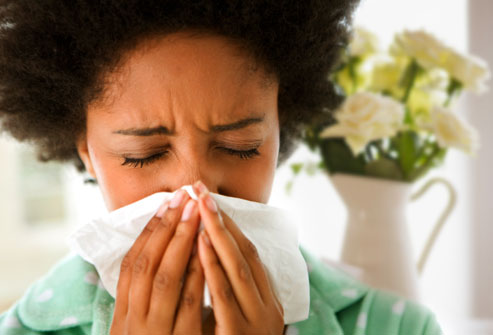Check Out: 5 Home Remedies for Seasonal Allergies

Many kids and adults tend to suffer from allergies due to weather changes, some are allergic to winter or summer and so fourth. Runny nose, itchy eyes, and the infuriating sensation of not being able to sneeze?. When it comes to home remedies for allergies you hear a lot about local raw honey preventing them. It is supposed to work because the gradual intake of local pollen will help build up your immunity before the symptoms start, thereby providing relief when the season actually hits. Here are five Home Remedies for Seasonal Allergies below…

1. Apple- Walnut Trail Mix
This mix will help you hit the trail in no time, without the sneezing and itching. Walnuts are a daily snack that you can enjoy to help ease allergy symptoms. High in magnesium, they help tamp down any wheezing or coughing that’s taking place, while their vitamin E content can boost immunity and protects your body from reacting to allergens. Apples, like onions, contain quercetin, and naturally reduce the production of histamine. Several studies have confirmed that an apple a day really does keep allergies at bay.
You will need…
-1/2-1 cup of walnuts
-1 apple
Directions
Chop the walnuts and cut the apple into medium-small chunks. Place both in a bag and toss until thoroughly mixed. Feel free to substitute pecans or walnuts if you prefer. You can also add in some other little tasty ingredients if you like (I like adding dried cherries and sunflower seeds.)
2. Nettle-Peppermint Tea
Nettle has such a negative image, but it’s one of the most incredible herbs you will use once you add it to your repertoire. From relieving arthritis, lowering blood pressure, and helping seasonal allergies, it performs a wide variety of functions thanks to its property names. The peppermint contains a type of flavonoid called luteolin-7-O-rutinoside which can help inhibit the activity and secretion of anti-inflammatory enzymes, such as histamines, and greatly reduce the dreadful discomfort that comes along them.
You will need…
-1 teaspoon of dried peppermint OR ¼ cup chopped fresh peppermint
-1 teaspoon of dried nettle leaf OR ¼ cup chopped fresh nettle leaf
-Honey and lemon to taste (optional)
-8 ounces of fresh water
Directions
It doesn’t get much simpler than this recipe! Place the nettle and peppermint in a mug and cover with boiling water. Steep them for 10-15 minutes, strain; add honey to taste, and drink 2 times daily as needed for allergy relief.
3. Bee Pollen
If local honey isn’t doing the trick for you, try bee pollen. The same concept lies behind how it works-starting in small amounts and gradually increasing the dosage daily will help build up your immunity to the pollen in your area. This is a play off what is known in medicine as “the hygiene hypothesis”, in which childhood exposure to germs and bacteria are vital to developing an immune system that can handle those same things down the line. Here you expose yourself to allergens before allergy season so your system doesn’t take a huge blow when the air fills with pollen. There are two vital parts to this remedy-first, make sure you are not anaphylactic or severely allergic to bees, or so allergic to pollen that you experience anaphylaxis.
Second, get local pollen. This will not work unless the pollen is local, as you need to build up a tolerance to the plants in your area. You also need to make sure that your pollen is coming from a good source, and free from insecticides. There are 3 forms (granules, capsules, and powder) but I prefer granules. Bee pollen is crunchy, musty, and very floral-enjoy it plain or sprinkle some over yogurt or oatmeal in the morning!
You will need…
-LOCAL bee pollen granules
Directions
Start taking pollen 5 months before your allergies flare. Start with 1 or 2 granules under the tongue and let them dissolve or chew them. The next day increase the dosage by 1 granule. Continue this until you feel confident that you will not have a reaction (I recommend doing this for about 2 weeks.) If you experience no adverse reaction, you can take up to 1 tablespoon daily throughout allergy season.
3. Refreshing Citrus Drink
Since many allergies peak in the spring and summer, they happen to coincide with warm, sunny days that you want to enjoy by frolicking in the great outdoors. As healing as tea is, sometimes you just need that tart, cool, refreshing drink at your side. This citrus filled drink contains plenty of vitamin C, which can provide relief from seasonal allergies, thanks to its incredible ability to nourish the immune system. Since the immune system is struggling to function right when you experience allergies, the benefits of this are obvious!
You will need…
-1/2 lemon
-2 oranges
-1 tablespoon of local, raw, organic honey
Directions
Squeeze the juice from the lemon and oranges and chill for several hours. Stir in the honey, add some ice cubes, and drink daily.
5. Red Onion Water
Onions contain a water soluble chemical compound called quercetin, which has been demonstrated in preliminary studies to reduce the amount of histamine produced by the body, therefore reducing symptoms of allergies. It is, essentially, nature’s version of an anti-histamine. Quercetin itself has also been shown to inhibit inflammation, as well as act as a bronchodilator, opening up airways and helping you breathe easier.
You will need…
-1 red onion
-4 cups of water
-Organic, raw, honey to taste
Directions
Thinly slice the onion and add it to the water. Allow it to infuse for 8-12 hours before drinking 1-2 times daily. It will keep in the fridge for up to 4 days. Stir some honey into individual glasses when you drink it if you like (I personally recommend it.)




